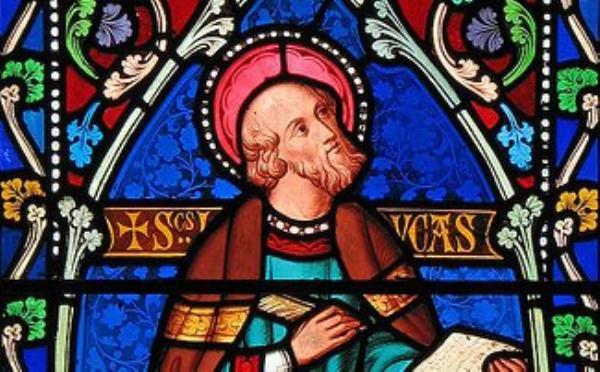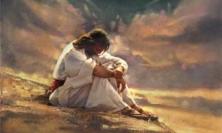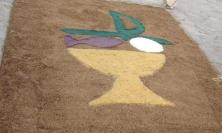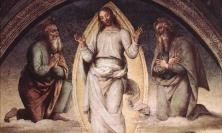The gospel readings for five of the Sundays during Lent this year come from Luke’s Gospel. Peter Edmonds SJ suggests that these readings, when taken together, form a short story of their own, and in this article he outlines the narrative that we will follow over the course of the next few weeks.
If Catholic Mass-goers were questioned as they left church on a Lenten Sunday about the gospel reading they had just heard, would they be able to say what is special about the Lenten gospels compared with those of previous Sundays? They may well be aware that they are taken from the same evangelist as the passages we hear on the Sundays before Lent, but they are selected from widely separated parts of the gospel. They form a short story of their own, which is the subject of this brief study. In Year C of the Sunday Lectionary, these readings are from Luke. It is his voice that helps us follow Jesus during our Lenten journey. We hear Luke on the first four Sundays of Lent and again on Passion Sunday.
SUNDAYS 1-4 IN LENT, YEAR C
Sunday 1: Jesus Alone: ‘The Temptations’ (Luke 4:1-13)
On this first Sunday of Lent, the only human being in view is Jesus himself. He is in the desert. He is there because the Holy Spirit has led him there. Previously he has passed through the waters of baptism, just as Israel of old had passed through the Red Sea (Exodus 15). Now, again like Israel (Numbers 20), he enters into the desert for a time of testing. There he meets the devil who bombards him with three temptations. These are not evil in themselves, but Jesus knows that to submit to them would destroy the mission before him. The words of scripture, the voice of God, confirm his choice. But we have to be careful how we understand scripture, because in the third temptation it is the devil that quotes scripture. As Paul remarked, Satan can turn himself into an angel of light (2 Corinthians 11:14). Luke’s narrative is almost identical to that of Matthew, with very minor modifications. Experts recognise here ‘Q’ material; that is, they suspect that Matthew and Luke are following a common source. In this passage we meet the human side of Jesus. This can help us deal with the temptations we meet in our own lives.
Sunday 2: Jesus and Three Disciples: ‘The Transfiguration’ (Luke 9:28-36)
On this second Sunday of Lent, we find ourselves on a high mountain with Jesus and his three senior disciples. There, Jesus’s clothing became brilliant as lightning and he appeared in glory with Moses and Elijah. The point of this vision would be to encourage those disciples who have just heard for the first time details of the suffering and death that awaited Jesus. This vision is also recounted in Mark and Matthew, and in such examples of ‘triple tradition’, we surmise that Mark’s version was a model for the other two. However, Luke makes two interesting modifications. He tells us that Jesus went up the mountain to pray: in Luke’s Gospel, Jesus prays at all the major turning points in his life. He also informs us of the subject of the conversation of Moses and Elijah with Jesus; they were speaking of the ‘exodus’ he was to accomplish in Jerusalem. ‘Exodus’ is a word that calls to mind all that happened when, centuries before, Israel won her freedom by her escape from Egyptian oppression. Jesus was soon to bring deliverance to God’s people from sin. This vision of Jesus in glory consoles disciples of our own time to persevere in their Christian commitment. All of us are to listen to the words that came from heaven, ‘This is my Son. Listen to him’.
Sunday 3: Jesus and the Crowds: ‘The Blood of the Galileans’ (Luke 13:1-9)
On the third Lenten Sunday, we join Jesus on his journey to Jerusalem. This journey lasts ten chapters in Luke. Its content seems to owe nothing to Mark, but it contains material similar to that of Matthew and as such is attributed to the source ‘Q’. But on this Sunday and the next, Luke’s work has no parallels in other gospels. It is true Lucan material. The best image by which to understand Jesus on his journey is that of a prophet like Isaiah or Hosea (Luke 24:19): someone who calls a sinful people to repentance (e.g. Isaiah 1:16; Hosea 6:1), who pleads with them to turn aside from sin and to live in accordance with the Law of Moses. So Jesus reacts to the tragic deaths of those killed by Pilate’s soldiers and to the fate of those who perished through the fall of a tower, with a call to the crowds around him to repentance. God was offering them the chance of salvation; they must not miss it. He also spoke a parable about a fig tree. The fig tree whose barrenness symbolised the people’s failure to live out the life that God wanted them to live, would soon be cut down, but not immediately. God in his mercy was giving them more time. This third Sunday reminds us that Lent is a time for repentance and penance.
Sunday 4: Jesus and His Critics: ‘The Prodigal Son’ (Luke 15:1-3, 11-32)
On this fourth Sunday, Jesus continues his journey to Jerusalem, but this time he is addressing his opponents, religious leaders who were criticising him because of the company that he kept, especially when at table. Generally Jesus did not give a straight answer to such critics. He would either ask them a question in return or tell them a parable, often one whose ending teased them to discover its application. The parable known as the Parable of the Prodigal Son is one such. It contains three characters, each of whom challenges us as to their significance. The first son is the obvious sinner who comes to repentance. The second son seems to have many qualities, but because he is ignorant of the return of his younger brother and does not address his father as father, we suspect that his situation was worse than that of his dissolute brother. The father who watches out for this first son, who interrupts his speech of contrition and rewards him with ring, robes and shoes, challenges every conventional picture of God. On this Lenten Sunday, we can question with which of the sons we identify and ponder how far our image of God corresponds with the God whom Jesus proclaimed.
PASSION SUNDAY, YEAR C
Passion Sunday provides us with the longest gospel reading of the year. Early Christians would have known the outline of the events of the passion story; just as their Jewish contemporaries recited the narrative of the Exodus from Egypt every year as part of their Passover celebration, so Christians would remind one another of the ‘exodus’ that Jesus accomplished in Jerusalem (Luke 9:31). But Luke told the story in his own way, making additions, omissions and modifications to this traditional story. We select some of them, beginning where the reading for Passion Sunday begins. Events that preceded the actual passion, when Jesus is alone with his disciples, indicate how we are to interpret and pray the passion itself when Jesus is exposed to the fury of his enemies.
The Preparation for the Passion (Luke 22:14-46)
We select four items included in the thirty verses which Luke gives us before he turns to the passion story proper. The first is his institution of the Eucharist. Luke’s account is special in that Jesus gives his disciples the cup twice. He speaks not of the blood of the covenant, following Matthew (26:28) and Mark (14:24), but, like Paul to the Corinthians, of the new covenant (1 Corinthians 11:25). This new covenant was promised by the prophets Jeremiah (31:31) and Ezekiel (36:26); it contrasts with the covenant celebrated by Moses at Mount Sinai (Exodus 24:8). His blood is not given ‘for many’ as in Mark and Matthew, but ‘for you’. Here, as elsewhere (6:20), Luke is the most personal of the gospels. Luke, like Paul, also adds Jesus’s instruction, that this is to be done in his memory (1 Corinthians 11:25).
Included in his preface to the gospel was Luke’s intention to give an ‘orderly’ account of the events he describes (1:3). Thus incidents familiar from other gospels are found in a different place in Luke. The disciples’ dispute about greatness is an example: in Mark, it is situated during Jesus’s journey to Jerusalem (Mark 9:34); Luke includes it in his account of the Last Supper. Jesus has the final word: he was among them as one who serves (22:27). In John’s gospel he performed the duty of a servant in washing the feet of his disciples (John 13:1-20). Such sayings and actions of Jesus remind us how the events of Calvary were understood in the early Church as the fulfilment of the servant prophecies of Isaiah (Isaiah 52:13-53:12). Jesus went to his death as the servant who ‘took our infirmities and bore our diseases’ (Isaiah 53:4; Matthew 8:17).
Luke stresses throughout his gospel the personal care of Jesus for his disciples. He assured Peter at his call, ‘Fear not’ (5:10). Before he chose the Twelve, he prayed the whole night long (6:12). After his resurrection, he accompanied two despairing disciples walking to Emmaus (24:15). So before his passion, this greatest of crises, he makes a special prayer for Simon Peter, his leading disciple, fully aware of the denials that lie ahead (22:31). Now that Jesus has taken his place, ‘at the right hand of the power of God’ (22:69), he remains our advocate (1 John 2:1), as Stephen learnt by his vision of Jesus when he was being stoned to death (Acts 7:56).
One of the most dramatic scenes in the gospels is the personal prayer of Jesus before his arrest. Luke describes this scene in his own way. He names the place as the Mount of Olives rather than Gethsemane. All the disciples followed Jesus, who addressed them before and after his own prayer with the words, ‘Pray that you may not enter in the time of temptation’. He himself prays to God as his Father in words reminiscent of the prayer he had previously taught his disciples which we call the Lord’s Prayer (11:1-4). He is giving them, and us, an example. The disciples are hardly blamed for having fallen asleep and Jesus does not repeat his own prayer (Matthew 26:36-46; Mark 14:32-42).
The Passion Story Proper (Luke 22:47-23:56)
This is commonly divided into four acts. Jesus is no longer alone with his disciples. He is thrust into the cynicism and violence of Jerusalem at its busiest, when the whole city was groaning with the crush of pilgrims for the Passover celebrations and the Roman governor was in residence. The first act of the passion narrative, the arrest scene (22:47-53), Luke structures in his own way. Jesus speaks first to Judas. He addresses him by name, as if making a final personal appeal. He then speaks to his disciples who attempt to defend him. Luke omits all reference to their flight. Jesus heals the ear of the servant of the high priest. Finally he makes a solemn statement to the authorities who are present in person. In sum, Jesus, as one who serves, continues the teaching and healing work of his ministry. Each evangelist recounts the story of Jesus’s arrest. It is profitable to listen out for the special message each gives us (Matthew 26:47-56; Mark 14:43-52; John 18:3-11).
The second act has Jesus on trial before the Jewish authorities, and the denials of Peter. Luke deals first with the latter. He cannot overlook them, but he describes them in gentler language than Mark and Matthew. Peter does not swear in this gospel. Luke reports how, after their conclusion, ‘The Lord turned and looked at Peter’ (22:61). Luke situates the main trial in the morning. He gives us a clearer list of the charges against Jesus. In his reply to the council, Jesus speaks of his taking his seat at the right hand of God ‘from now on’. This anticipates his words to the penitent thief that today he would be in paradise (23:43).
In the third act, Jesus is on trial before Pilate. In Luke, as in John, three times Pilate declares Jesus to be innocent (23:4, 14, 22). Introducing Herod to the story, Luke indicates that Herod had reached the same verdict. Jesus even here continues his work of reconciliation because Pilate and Herod became friends on that day (23:12). This message of the innocence of Jesus was one for Lucan Christians to take to their sceptical Greek world.
In the fourth act, Jesus is crucified, dies and is buried. We know about Simon of Cyrene from other gospels, but only Luke tells us that he carried the cross ‘behind Jesus’ (23:26). Jesus continued his mission of consolation when he spoke to the women of Jerusalem (23:29). He accepted the repentance of the penitent thief, promising him a place in paradise (23:43). He did not die with a loud cry, but with words of forgiveness for his executioners and a prayer of confidence to his Father (23:34, 46). Finally, the people returned to their homes, beating their breasts, a sign of repentance (23:48). Joseph of Arimathea, a good and righteous man, buried him, and the women who had come with him from Galilee prepared to anoint his body (23:53,56). Luke would look for similar responses from those who had heard his account of the passion from the words of the institution of the Eucharist to its conclusion.
At the end of the explanation of the Parable of the Sower in his gospel, Luke reported how Jesus concluded with the words, ‘As for that in the good soil, these are ones who, when they hear the word, hold it fast in an honest and good heart, and bear fruit with patient endurance’ (8:15). May this also be the result of our listening to the voice of Luke during this Lent. In this Year of Faith, may it be that we do not so much accompany Jesus on his Lenten journey as allow him to accompany us during ours.
Peter Edmonds SJ is a member of the Jesuit community at Stamford Hill, North London.
Further Reading:
![]() Peter Edmonds, Rediscover Jesus, a pilgrims’s guide to the land, the personalities and the language of Luke (Kevin Mayhew, 2007)
Peter Edmonds, Rediscover Jesus, a pilgrims’s guide to the land, the personalities and the language of Luke (Kevin Mayhew, 2007)![]() ‘How to read the Gospel of Luke’ by Peter Edmonds SJ
‘How to read the Gospel of Luke’ by Peter Edmonds SJ![]() ‘Keeping Lent with Saint Luke’
‘Keeping Lent with Saint Luke’






